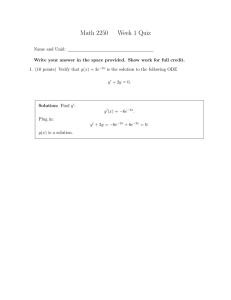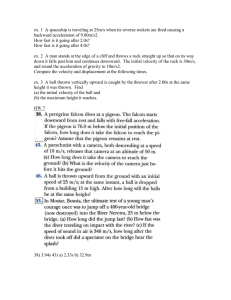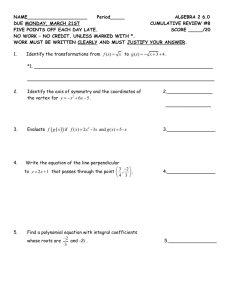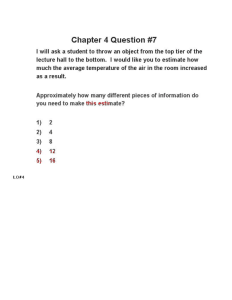Assessing Student Reasoning
advertisement
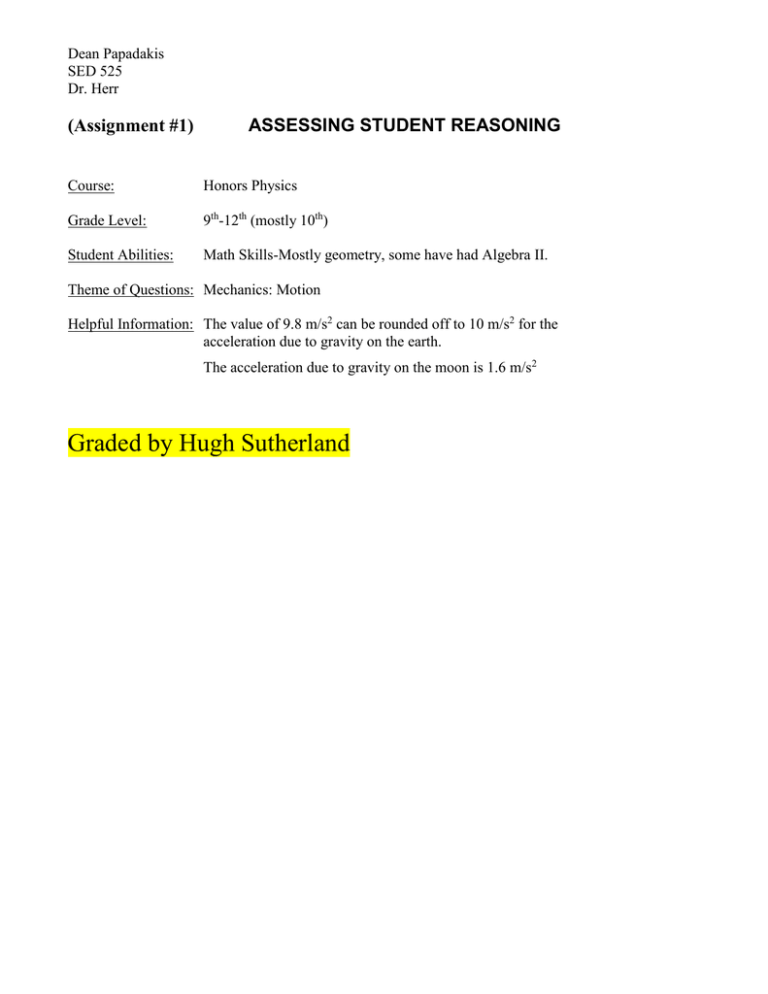
Dean Papadakis SED 525 Dr. Herr (Assignment #1) ASSESSING STUDENT REASONING Course: Honors Physics Grade Level: 9th-12th (mostly 10th) Student Abilities: Math Skills-Mostly geometry, some have had Algebra II. Theme of Questions: Mechanics: Motion Helpful Information: The value of 9.8 m/s2 can be rounded off to 10 m/s2 for the acceleration due to gravity on the earth. The acceleration due to gravity on the moon is 1.6 m/s2 Graded by Hugh Sutherland Level of Reasoning Knowledge Question In a displacement vs. time graph showing the motion of a moving car, what is the correct name given to the slope of the graph? a) Speed c) Acceleration b) Velocity d) Hyper-Acceleration A ball is thrown up into the air and allowed to fall back to the ground. Comprehension In which direction is the force of gravity acting, as the ball is moving upwards? a) Gravity is acting upwards, helping the ball to move upwards. b) Gravity is acting downwards, though the ball moves upwards. Application c) Gravity is acting in both directions, upwards & downwards. If you throw a ball straight down from the science balcony, while you simultaneously drop another identical ball from the same height, how will the accelerations of the two balls compare? a) The thrown ball will have a greater acceleration. b) The dropped ball will have a greater acceleration. Analysis c) Both thrown and dropped balls will have the same acceleration. If the ball in the previous question, were thrown downwards from the balcony with an initial speed of 14 m/s, instead of just being dropped, what would its speed be one second after being thrown? Confusing because in the above question there are 2 balls, 1 dropped and 1 thrown. If a ball is thrown downward from the balcony with an initial speed, etc. Synthesis Evaluation a) 10 m/s c) 24m/s b) 14 m/s d) 45 m/s c) 20 m/s A ball is thrown upward into the air. Assuming that no air resistance is acting on the ball, explain how the acceleration of the ball varies while it is traveling upwards and then while it is traveling downwards? “Explain” tends to be a comprehension word. Since this question may be better as a comprehension type question, I could use it as a follow up question to the existing comprehension question above, and find another question to put here for the synthesis type of question, such as: “One ball is dropped off a balcony, while another ball is thrown off the balcony at a speed of 5 m/s, while another ball is thrown off the balcony with a speed of 8 m/s. Construct a distance vs. time graph and a velocity vs. time graph for the three different balls and sketch what these graphs might look like. I. An astronaut is on the moon and simultaneously drops a feather and a hammer. How do we explain the fact that they both land on the ground at the same time? Rephrase as an ‘evaluation’ question. These multiple choice responses could be removed so that the question reads, “Defend this result to another student and convince the other student why this result occurs.” a) no gravity forces act on a body in a vacuum. b) g on the moon is less than g on the earth. c) in the absence of air resistance, the ratio of any object’s weight to its mass is a constant value. d) the feather has a greater weight on the moon than on the earth. II. What would be the value of the speed of the feather, one second after being dropped to the ground? How is this question at a different level than the very similar Analysis question? It is best to just remove this question since it really belongs above in the Analysis section. Answers to the 6 Levels of Reasoning Questions (for Mechanics-Motion): Knowledge Question #1 b) velocity Comprehension Question #1b) Gravity is acting downwards, though the ball . . . . . . Application Question #1 c) Both thrown and dropped balls will have the same . . . Analysis Question #1 c) 24m/s Synthesis Question #1 The acceleration of the ball does not vary while being thrown upwards, it stays constant at 10 m/s2 and is directed in the downward direction. When the ball is traveling downwards, the acceleration of the ball again does not vary and remains constant at 10 m/s2 and is still directed in the downward direction. Evaluation Question #1 c) in the absence of air resistance, the ratio of any object’s weight to its mass is a constant value. Evaluation Question #2 Since the acceleration due to gravity on the moon, is 1.6 m/s2 and since there is no air on the moon, this means that the value for air resistance is zero, so the speed of the feather would be found from vf = vi + gt or (zero + 1.6 m/s2 x 1 second), which equals 1.6 m/s Dean Papadakis SED 525 Dr. Herr (Assignment #1) (Question set 2) ASSESSING STUDENT REASONING Course: General Chemistry Grade Level: 11th-12th (mostly 11th) Student Abilities: Math Skills-Mostly geometry, some have only had Algebra I. Theme of Questions: Organic Chemistry Helpful Information: Types of Functional Groups 1. 3. 2. 4. Level of Reasoning Question What is the general formula for the alkenes family? Knowledge Comprehension a) CnH2n+2 c) CnH2n b) CnH2n-2 d) CnHn Match the term below with the statement that most closely matches. Each answer is used once. a) organic d) alcohol b) saturated e) hydrocarbon c) aldehyde or ketone 1. Compound whose only two elements are carbon and hydrogen. 2. Substance that contains one –OH group as its only functional group. 3. Substance that contains one C=O bond as its only functional 4. group. Compound that contains the maximum number of hydrogens (no multiple bonds or rings). 5. Branch of chemistry that deals with compounds of carbon. This is a vocabulary recognition question which is usually ‘Knowledge’. This question could be adjusted so as to be more in line with a comprehension question by asking the following question instead: Describe how how an alkene molecule is different from an alkane molecule. Application I. Which formula represents a member of the same hydrocarbon family as C8H14? a) C4H6 c) C4H8 b) C4H7 d) C4H10 II. What kind of hydrocarbon is C8H14? ____________________ Analysis Referring to the chart in the “Helpful Information” section above, match the terms below with the correct functional group. 1. Functional group 1 is most closely associated with a) aldehydes c) ketones b) acids d) alcohols 2. Functional group 2 is most closely associated with a) alcohols b) aldehydes c) ethers d) ketones 3. Functional group 3 is most closely associated with a) acids c) ketones b) aldehydes d) alcohols 4. Functional group 4 is most closely associated with a) esters c) ketones b) acids d) aldehydes Synthesis I. How many carbons make up the “parent chain” in the following molecule? a) 4 c) 6 b) 5 d) 7 II. What would be the correct I.U.P.A.C. chemical name of this molecule? _________________________________________ III. Draw one possible isomer of this eight carbon molecule. Evaluation I. When an alcohol reacts with a carboxylic acid: a) an ester forms. b) the product often has a nice smell. c) a water molecule is produced. d) all of these occur. II. If the alcohol used is methanol, and the carboxylic acid used is salicylic acid (as was done in the classroom experiment), what would be the correct chemical equation (showing structural formulas) for this reaction? This is a “synthesis” question. Here is an alternate version of this question that would make it more in line with an evaluation type of question. What would you need to do as an organic chemist in order to change the flavor or aroma of this wintergreen molecule (that was synthesized) to a different flavor or aroma? Answers to the 6 Levels of Reasoning Questions (for Organic Chemistry): Knowledge Question #1 c) CnH2n Comprehension Question #1 1. e) hydrocarbon 2. d) alcohol 3. c) aldehyde or ketone 4. b) saturated Application Question # I Application Question # II a) C4H6 alkyne Analysis Question #1 Functional Group 1 is b) acids Functional Group 2 is c) ethers Functional Group 3 is d) alcohols Functional Group 4 is d) aldehydes Synthesis Question # I c) 6 Synthesis Question # II 3,4-dimethyl hexane 5. a) organic | | | | | | | | Synthesis Question # III —C—C—C—C—C—C—C—C— | | | | | | | | How would you describe the other possible answers? I would draw out the other isomers, but it was difficult for me to draw them with Microsoft Word. The end carbon could for example be moved to the third carbon from the end, to make another isomer. Evaluation Question # I a) an ester forms. Evaluation Question # II + → + H2O Dean Papadakis SED 525 Dr. Herr (Assignment #1) (Question set 3) ASSESSING STUDENT REASONING Course: Honors Physics Grade Level: 9th-12th (mostly 10th) Student Abilities: Math Skills-Mostly geometry, some have had Algebra II. Theme of Questions: Mechanics: Conservation of Momentum Helpful Information: Ft = mΔv and Total momentum before a collision is equal to the total momentum after the collision. Dean, take a look at Table 6.2 Verbs to reformulate some of these questions. Append this to my return of Question sets 1-2 and then send your revised version to me to score. Thanks, Hugh Level of Reasoning Question The SI unit of momentum is ...? Knowledge a) N. m c) N . s b) N/s d) N/m If the velocity of an object is doubled, and the mass of the object is Comprehension tripled, by what factor will its momentum change? a) 2 c) 5 Application b) 4 d) 6 A 0.060 kg tennis ball is moving at 12 m/s and is struck by a racket causing it to rebound in the opposite direction at a speed of 18 m/s. What is the change in momentum of the ball? a) 0.36 kg .m/s c) 1.1 kg .m/s b) 0.72 kg .m/s Analysis A small bomb of mass 10.0 kg is moving toward the north with a velocity of 4.0 m/s. It explodes into three fragments: a 5.0 kg fragment moving west with a speed of 8.0 m/s; a 4.0 kg fragment moving east with a speed of 10.0 m/s; and a third fragment with a mass of 1.0 kg. What is the velocity of the third fragment? (neglect air friction) a) zero Synthesis d) 1.8 kg .m/s c) 40 m/s So. b) 40 m/s No. d) none of these This is a ‘calculate’ word problem and is ‘application’. I agree that this is a “calculate” word problem, but I believe that it does require a bit more analysis than the question stated above in the application question, because it requires an understanding of vector analysis in addition to conservation of momentum. The use of air bags which inflate in cars during a collision help save lives in accidents because they . . . . a) decrease the time of impact. b) decrease the impulse delivered to the occupant. c) decrease the force of impact on the occupant. d) all of these quantities are decreased during the collision. e) none of these is true. Evaluation This is an ‘analysis’ question based on F=ma. You are right, this may be better matched in the analysis section. A railroad diesel engine coasting at 16 km/hr runs into a stationary Flatcar. The diesel weighs 7 times as much as the flatcar. Assuming the cars couple and stay together, how fast are they moving after the collision? This is a ‘calculate/compute’ word problem so at most it is an application question. I guess I am having difficulty with creating evaluation questions and higher order thinking questions that are just multiple choice. I know that it does not have to be mutilple choice but I am more likely to use it if it is a multiple choice question. Answers to the 6 Levels of Reasoning Questions (for Mechanics-Motion): Knowledge Question #1 c) N . s Comprehension Question #1 d) 6 Application Question #1 d) 1.8 kg .m/s Analysis Question #1 b) 40 m/s No. Synthesis Question #1 c) decrease the force of impact on the occupant. Evaluation Question #1 14 km/hr My Reflections: After reviewing the comments by Hugh, I was surprised that I overlooked some of the comments that he made. Having another person review my questions, was very helpful to me and greatly improved my questions so that they would be much more usable for my own students. I also learned that is very challenging to make the questions on a test have enough variability so that they match the 6 levels of reasoning. I have always wanted to have questions that do have these varying levels, but feel that most of my questions have usually been following only about 3 levels, not 6 levels of reasoning. I am also happy that a higher order level of reasoning question, does not have to be an essay question, but in fact can still be a multiple choice question, if enough time is invested in the question, in order to make it appropriate for my students and appropriate for the higher order level.
